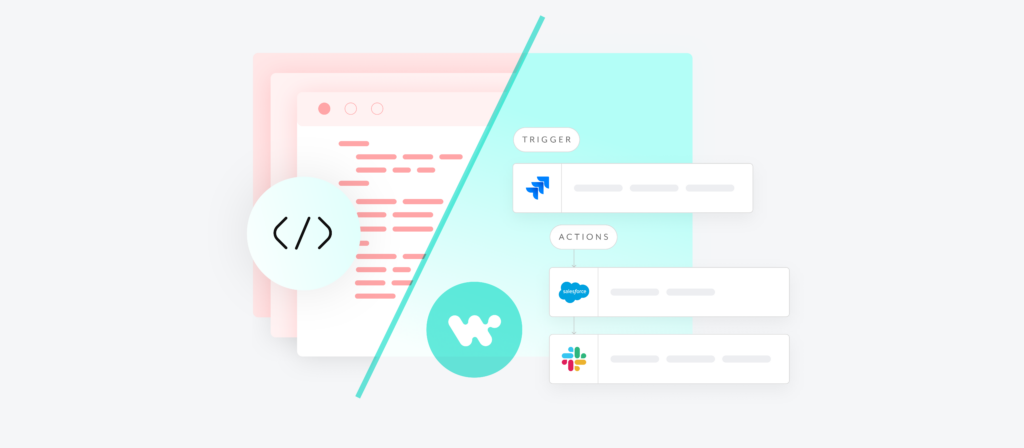In a world where speed wins, the no-code revolution promises agility, cost savings, and democratized innovation. The role of the business technologist is on the rise: tools now empower business IT and process builders to design systems, handle data, and architect workflows. And while these tools deliver, they also introduce a potential for hidden engineering debt when structure and governance are missing.
The challenge is rarely the platform—it’s how we use it. When democratized builders lack “engineering thinking,” agility can turn to chaos and risk. This 3-point cheat sheet is about thinking like an engineer so structure delivers freedom and guardrails become leverage. It’s a set of signposts to complement the speed and power of the Workato platform—if you want more guidance, Sandhata can help your team scale safely.
1: Think Before You Flow
Every successful business IT builder or process architect starts with the right questions:
- What measurable pain are we solving?
- Who owns the metric, and how will it change?
- What changes when this goes live, and who’s responsible for troubleshooting?
- How would this be triaged if something went wrong?
Not all automations are equal:
- Tier 1: Revenue paths, legal/compliance—require extensive testing, documentation, oversight.
- Tier 2: Operations flows—review, signoff, monitoring.
- Tier 3: Personal or team nudges—safe to experiment.
Understand your data:
- Where does it originate and end up?
- What transformations happen along the way?
- Who owns the schema?
2: Engineering-Grade Flow Architecture
Workato recipes aren’t code, but they still need engineering mindset:
- Break up large solutions into callable flows.
- Follow “one job per recipe” for clarity.
- Centralize utilities (logging, alerts, API calls) as shared modules.
- Version your library and enforce reuse—this prevents technical debt.
Best practices:
- Anticipate errors like an SRE; handle and monitor them proactively.
- Avoid hardcoded dependencies; think architecture, not scripting.
- Clear naming conventions distinguish clarity from chaos.
- Push logs to real monitoring (Splunk, Datadog, Elastic), including inputs, outputs, user IDs, execution time, status, and errors.
3: Legacy Integrations Don’t Translate 1:1
Workato is not legacy. When migrating from ESBs or older iPaaS tools, don’t copy code line-for-line. Use this opportunity to rethink and optimize your automation strategy:
- Refactoring isn’t just about savings—it’s about maximizing the platform’s strengths (modular flows, event-driven design, rapid change).
- Example comparison:
| Feature | TIBCO | Workato |
|---|---|---|
| Deployment Model | On-Prem/Cloud-Optimized | Cloud-Native, Serverless |
| Low-Code + Pro-Code | Developer-Focused, Java/XPath | Unified Low-/Pro-Code Builders (Any Skill Level) |
| Integration Patterns | APIs, JMS, Some Event | API, Events, Batch, Files, RPA, AI Agents |
| Upgrades & Maintenance | Manual, High-Touch, Regression Testing | Zero-Downtime, Automated, No Regression Required |
| Governance & Security | Basic RBAC, Add-On Compliance | Enterprise-Grade out-of-the-box: Runtime user authentication, RBAC, BYOK, Hourly key rotation, and more. |
| Composability & Modular Reuse | Custom Coding, Reuse Limited | Modular, Reusable Recipes & Skills, Library Versioning |
| AI & Agentic Readiness | No Native Enterprise AI/Agents | Native AI Agents, Agent Studio, Multi-Agent Orchestration |
| Ecosystem Interoperability | JMS-Native, Proprietary Integrations | Vendor-Neutral, 1,500+ Prebuilt Connectors, No Lock-In |
| Speed to Value | Multi-Month Projects | Weeks to Production, Rapid Expansion |
You’re not just migrating—you’re rearchitecting.
Final Word: Build Like It Will Outlive You
Workato makes it easy to start—but easy to lose structure if you don’t plan. Your role as a business technologist or democratized builder is to design for long-term growth, not just point solutions:
- What’s the core business logic?
- What are the true events, triggers, and outcomes?
- What really belongs in Workato, and what doesn’t?
Governance and observability are vital—look for more on these in our next blog.
If you need professional mentoring to empower your business IT and process builders, Sandhata is here to help.
We believe business technologists are most successful with structure and support—not solo. This guide is just the beginning; Sandhata can help bridge the knowledge gap and deliver reliable, scalable systems your business can own with pride.
Want a companion checklist, playbook, or enablement session for your team? Let’s build it together.
Anitha Govindasamy is Head of Integration Engineering for Sandhata. For more information about how Sandhata can help drive value for your organisation, click here.
